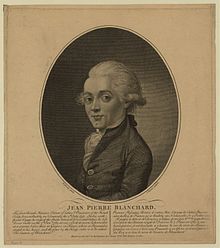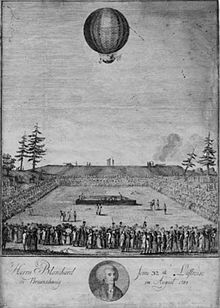Jean-Pierre Blanchard
Jean-Pierre François Blanchard (born July 4, 1753 in Les Andelys , † March 7, 1809 near Paris ) was a French balloonist .
Life
Jean-Pierre Blanchard initially experimented unsuccessfully with his own flying machines, which were based on flapping wings. After the development of the hot air balloon by the Montgolfier brothers and the gas balloon by Jacques Alexandre César Charles in 1783, he turned to balloon flight; March 2, 1784, he started from the Champ de Mars in Paris to his first balloon flight with a with hydrogen -filled balloon . He drove over the Seine and back again. On July 18, 1784, Blanchard and his companion were approaching for landing after a successful balloon flight in Normandy . It is anecdotally reported that the balloonists were greeted in disbelief by crowds of wildly gesticulating farmers. Some fell to their knees, clasped their hands in prayer, others ran away in horror. One of the men on the ground is said to have shouted upstairs, “Are you people or gods? Let yourself be recognized! ”-“ We are people like you! ”, The aviation pioneers are said to have replied and to have thrown their coats down as proof.
On January 7, 1785, he and the doctor John Jeffries were the first to cross the English Channel from Dover to Calais in an adventurous ride in a gas balloon in two hours and 25 minutes . The balloonists finally had to throw off all ballast (except for their underpants) and climb from the gondola onto the holding ropes so as not to fall. An enthusiastic reception awaited them in Calais. Blanchard was made an honorary citizen of Calais and received a lifetime payment of 1200 livres annually from the French king.
Then he appeared publicly as a balloon showman. On October 3, 1785, he started in Frankfurt am Main on the occasion of the autumn fair for the first air journey in Germany and drove from the Bornheimer Heide near Bornheim to Weilburg an der Lahn. Blanchard claimed the invention of the parachute for himself and on this ascent let his dog float down to earth with the parachute for the first time, which also reached its destination safely.
This parachute saved Blanchard's life on November 21, 1785. Blanchard's balloon threatened to burst due to overpressure; Blanchard poked a few holes in the case to prevent this from happening. The gas was now flowing out so quickly that a crash was imminent and he could only save himself with his parachute. This was the first guaranteed - albeit involuntary - parachute jump of a person from a great height; Louis-Sébastien Lenormand (1757-1837) had jumped from the observatory in his hometown of Montpellier two years earlier. In addition, this was the first air rescue in the history of aviation .
On August 23, 1786 he took off again in Germany and climbed up in Hamburg , where he let a mutton float safely to earth on a parachute. In 1787 the Blanchard balloon rose in Nuremberg , an event that also had a large audience there. Two years later, Blanchard made an ascent just outside the city of Braunschweig . This event, on August 10, 1788, processed the writer Adolph Freiherr Knigge (1752–1796) for his satirical novel Die Reise nach Braunschweig .
On September 27, 1788, Blanchard rose in Berlin from the parade ground in the Tiergarten and landed in the area of today's Karow district , where the Ballonplatz and Blanchardstrasse today commemorate this event. After a performance in Hanover in 1790 , the city's magistrate made him an honorary citizen .
He made another ascent with his hydrogen balloon on July 6, 1791 in Vienna . He took off from a meadow in the Prater and landed in the eastern suburb of Groß-Enzersdorf . Among the eyewitnesses of this balloon trip was Emanuel Schikaneder , who was writing the libretto for the Magic Flute at the time . Schikaneder dealt with the event by letting three boys float away in the Magic Flute with a balloon.
Blanchard made his 28th gas balloon flight to Nuremberg on November 12, 1787. After the start, thousands of the estimated 50,000 to 60,000 spectators followed the balloon across the harvested fields. To this day, the saying in Nuremberg: "No look here, he runs like at Blenscherd."
Blanchard also launched the first balloon flight in the New World . He took to the skies in Philadelphia on January 9, 1793 in the presence of George Washington and landed in Deptford, Gloucester County, New Jersey.
In 1804 he married the twenty-six year old Marie Madeleine Sophie Armant, who also developed into an avid balloonist. So Sophie Blanchard and her husband crossed the English Channel in the opposite direction from Calais to Dover.
When Blanchard died of a stroke while ballooning on March 7, 1809 , his wife became the first balloonist to continue the series of demonstrations.
Honors
- A lunar crater with a diameter of about 40 km and the Blanchard glacier in Antarctica are named after Jean-Pierre Blanchard .
- In Frankfurt am Main, Blanchardstrasse in the Bockenheim district is named after him.
literature
- Günter Schmitt, Werner Schwipps: Pioneers of early aviation. Gondrom Verlag, Bindlach 1995, ISBN 3-8112-1189-7 , pp. 9-19.
Web links
- Literature by and about Jean-Pierre Blanchard in the catalog of the German National Library
- In the air with wine and milk rolls
- The first balloon ride over Nuremberg
- Detailed reports on Blanchard in Frankfurt
- Tripota - Trier portrait database
- [1]
Individual evidence
- ^ Max Döllner : History of the development of the city of Neustadt an der Aisch up to 1933. Ph. C. W. Schmidt, Neustadt a. d. Aisch 1950, OCLC 42823280 ; New edition to mark the 150th anniversary of the Ph. C. W. Schmidt publishing house, Neustadt an der Aisch 1828–1978. Ibid 1978, ISBN 3-87707-013-2 , p. 341.
- ^ Adolph Knigge: The journey to Braunschweig; a comic novel . Reprint of the first edition in 1792. Wenderoth, Kassel 1972, ISBN 3-87013-001-6 .
- ↑ The tragic icon of the balloon flight. July 7, 2019, accessed July 7, 2019 .
- ↑ Blanchardstrasse in the Frankfurt-Zoom portal : Where do you live? Facts About Your Street , accessed June 9, 2018.
| personal data | |
|---|---|
| SURNAME | Blanchard, Jean-Pierre |
| ALTERNATIVE NAMES | Blanchard, Jean-Pierre François (full name) |
| BRIEF DESCRIPTION | French balloonist |
| DATE OF BIRTH | 4th July 1753 |
| PLACE OF BIRTH | Les Andelys |
| DATE OF DEATH | March 7, 1809 |
| Place of death | near Paris |



